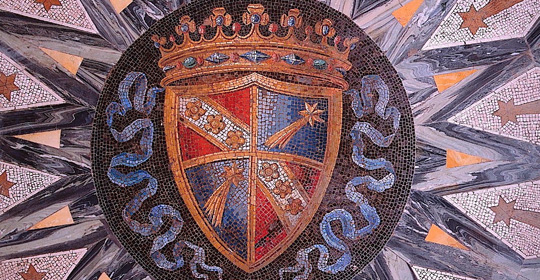The mosaics
Among the original decorations recovered in the House of the Princes the elaborate floor mosaics are certainly worthy of mention. The early nineteenth century was characterised in Rome by a revival of the taste for this ancient form of decoration, which gave life to a school of mosaics, and examples of which can be seen in the Gallery and in the Luncheon Room, made Carlo Seni to a design by Giovan Battista Caretti.

Mosaic is an artistic technique used for the decoration of floors, walls and ceilings, decorated with small fragments, more or less regular in shape, of various materials, such as pebbles hard stone, terracotta, glass, enamel, and marble. From the IIIrd century AD, excepting the oldest part of Nero’s Domus Aurea, works are also often found using glass tiles with gold foil.
These materials, generally shaped into rectilinear shapes, and called abakìskoi by the Greeks and abaculi, tesserae or tessellae by the Romans, were applied, following a precise decorative program, to walled surfaces, specially prepared with a cement solution.
The art of mosaics is expressed mainly through the use of rectilinear tile-pieces, more or less uniform in size and shape (opus tessellatum) or slabs of stone and marble of various colours cut to the shapes of the figures or composed in various geometric forms (opus sectile). Mosaic pavements were often enriched by a central figured square (emblema) which was created separately, in a specialist workshop, using tiny tile-pieces. In the central panel was set an octagon, which originally contained a round emblema in multi-coloured mosaic, showing Mars and Venus, which was subsequently moved to the House of the Owls and replaced with a slab of coloured marble.
In the remaining corners of the octagon, between four compressed hexagons, there were similarly figures of animals, made from tiny yellow tile-pieces, stand out against a white background. In the two mirror images which flank the central panel is set a circle, divided in its turn into triangles and lozenges, which converge on a central tondo, in which the Torlonia crest is displayed in polychrome mosaic.
In the large lozenges are depicted, again made from tiny yellow tile-pieces on a white field, putti in various attitudes, while the smaller lozenges show the heraldic comet of the Torlonia family, made using the same technique.
As in the central panel, the resulting corner sections contain compressed hexagons with figures of animals.
All the geometric divisions of the Gallery floor are framed by bands of bardiglio marble.
The floor of the Luncheon Room, by contrast, is sub-divided into squares, hexagons, triangles and eight large octagons, which are divided by bands of bardiglio marble with contrasting strips of coloured marble.
Inside these geometric divisions, musical instruments and Silenus masks are shown, made from black tile-pieces on a white background and, in the octagons, four Maenads alternate with four Satyrs, dancing and playing music.











































